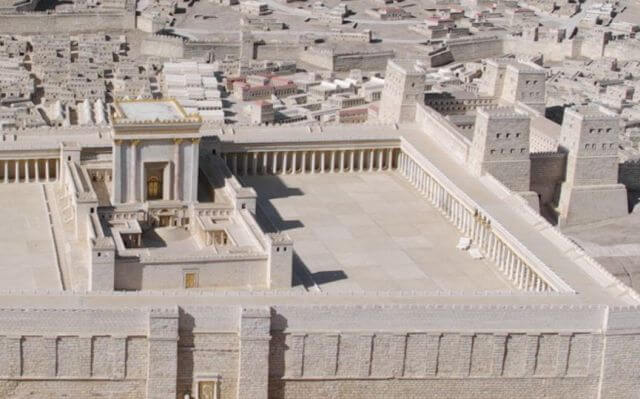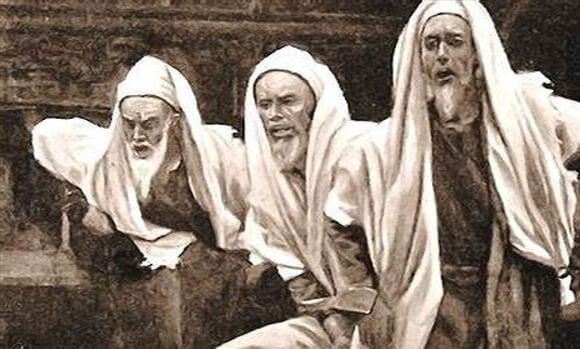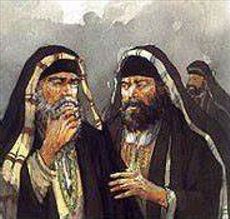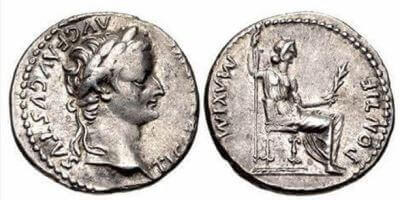COMMUNICATION 06 – Jesus‘ style: Pharisees & Herodians
Context of the passage Mark 12:13-17

It’s the last week of Jesus’ life, the final days leading up to the crucifixion.
- Mrk 11:1-11 Jesus entered Jerusalem triumphantly, raising Messiah hopes
- Mrk 11-12 Jesus at the temple under watchful eyes of spiritual & political leaders
- Mrk 11:15-19 Jesus has cleansed the temple with authority, and offended many
- Mrk 11:27-33 Jesus’ authority is questioned by the chief priests and scribes
- Mrk 12:1-12 Jesus in answer has told a searing parable about the wicked tenants
- Mrk 12:13-17 Pharisees & Herodians pose a question to find grounds against Jesus
The picture shows a reconstruction of Jerusalem with the temple to the left and the Roman military headquarters (the fortress Antonia) to the right.
Mark 12:13 “Then they sent him some Pharisees and some Herodians to trap him in what he said.”
- Situation: Jerusalem, in the temple. The last few days of Jesus’ life.
- He has lived and acted and taught publicly for over 3 years.
- Mostly it’s three groups that oppose Jesus: > the Pharisees
> the Herodians
> the Sadducees
Some background on the Pharisees
- They believed that if the Jews only kept the Law …
- then God would send the Messiah-Deliverer.
- then Israel would be a free nation again, delivered from oppressive, evil Romans.
- then the son of David would reign again.
- then the Jews would triumph and rule over all other nations.
- then godly priests would again offer proper sacrifices.
- They were a group of lay people, a popular religious movement among normal Jews.
- They taught the law in the synagogues of the villages and cities.
- They told Jews to live separately from Gentiles so as to ‘keep themselves clean’.
- They especially stressed circumcision, clean unclean laws and the sabbath.
- They were very respected by the normal Jews.


Some background on the Sadducees
- The Sadducees were the class of ruling priests and were very influential
- They were not pure-blood Aaronitic priests as per the law but
- They descended from the Maccabees, who had lead a successful revolt 200 y ago
- By now they are more interested in keeping power & privileges than in spiritual things: They cooperate with the Romans to maintain their status.
- The head of the Sadducees is the high priest.
Some background on the Herodians
- The Herodians were the family, beneficiaries and supporters of Herod, the local king
- When the Romans came to conquer Judea 100 years earlier, the Herod-family sided with the Romans against the Jews
- The Romans then put them in leadership as ‘local kings’ under Rome’s rule
- The Jews hated being ruled by the Herod-family who were collaborators – and Non-Jews! (Edomites, later Edomite-Jewish mixed blood)
Looking at the text verse by verse
Mark 12:13 “Then they sent him some Pharisees and some Herodians to trap him in what he said.”
- Pharisees & Herodians were arch-enemies and hated each other because:
- the Pharisees were the Jewish racists or purists
- the Herodians were the mixed-blood collaborators
- But here they unite because both have decided it is better for Jesus to die
- Why do the Pharisees want Jesus killed? They think him a false Messiah because:
- he does not uphold Jewish purity laws
- he does not uphold Jewish separateness from Gentiles
- he mixes with sinners, foreigners, collaborators, …
- Why do the Herodians want him killed? They think Jesus is a dangerous revolu-tionary, collecting followers to attack the Romans & free Israel
- in order to keep Rome happy, he must go
- if they can’t control the country, Rome will remove their leadership & privileges
- Pharisees working together with Herodians also shows that
- they are willing to compromise their principles for an important enough goal
- they think the end justifies the means
- they are more than just a ‘spiritual renewal’, they have political goals and involve in power games
Mark 12:14-15 “Teacher, we know that you are sincere and show deference to no one; for you do not regard people with partiality, but teach the way of God in accordance with truth.”
- They pose as honest seekers to trap Jesus
- They use flattery to the point of lying, for they do not think Jesus teaches truth
- Again: they are willing to bend their own laws
“Is it lawful to pay taxes to the emperor or not? Should we pay them or should we not?”
- They just took a question they can’t agree on among themselves!
- The question behind the question is: Is the Roman emperor lawful authority?
- this is the argument of the Jews of that time.
- if Jesus says ‘yes’, he will be branded as collaborator-conspirator, offending the Pharisees and most Jews.
- if Jesus says ‘no’, he will be branded as a revolutionary, calling people to civil disobedience, to a refusal of Roman rule and to a nationalist resistance.
- It’s a classical ‘one dimensional’ question (a ‘yes-no’ question):
- Yes-no questions force you to agree with their assumptions.
- Yes-no questions force you to make a decision in ‘their logic world’.
“But knowing their hypocrisy he said to them, “Why are you putting me to the test?”
- Jesus is not fooled, he understands the trap.
- Unlike them, Jesus is not using flattery nor deception > he is straight and honest.
- Jesus exposes their hidden agenda and plot.
- But he still answers … why?
- he will not retreat, escape or evade.
- he will show them the infinitely superior thinking of God.
- he will shake them up enough so they start asking questions.
- he hopes to get through to their hearts.
- he speaks for the listening crowd that is receptive, unlike the questioners.
Mark 12:15-16 “Bring me a denarius and let me see it.” And they brought him one. Then he said to them, “Whose head is this, and whose title?” They answered: the emperor’s.”
- Why is Jesus doing this practical illustration?
- he refuses a straight ‘yes-no’ answer.
- he is arousing interest.
- he is involving them, he forces them to start thinking again.
- he introduces new thinking.
- Maybe: he is shaming them, for Jews tried not to own that ‘dirty money’.
Mark 12:17 “Give to the emperor the things that are the emperor’s and to God the things that are God’s”. And they were utterly amazed at him.
- They cannot claim this is an evasion but rather are utterly amazed.
- Jesus does not specify what exactly is due to whom.
- Jesus moves away from a ‘black and white’ or ‘yes and no’ binary question.
What exactly is the brilliance of this answer?
- The temple had an own currency (shekel), does this simply mean pay taxes to whoever made the currency? This is too simple.
- What is Jesus saying? What is the assumption in their thinking that he doesn’t agree with?
- that to accept the emperor’s leadership means to refuse God’s leadership.
- Jesus declares both leaderships legitimate, the emperor’s and God’s, though they are different.
What exactly do we owe to whom, then?
- Government has the right to demand of its citizens:
- tax to fulfill the functions the government is responsible for.
- obedience to the law of the land.
- submission as far as the law requires.
- But: government does NOT have the right to:
- demand mental agreement or control decisions.
- unconditional, moral obedience of its citizens.
- demand worship.
What did the coin show?

- Jesus’ death year falls into the reign of Emperor Tiberius (14-37 AD).
- Original Tiberius denarius coins, – the coin Jesus refers to – have been found (see picture below) and are exhibited in museums.
- The Tiberius denarius coin’s head side read: ‘Ti(berius) Ceasar Divi Aug(usti)’ = Emperor Tiberius, son of Augustus.
- Augustus means ‘revered’, he took on the title ‘son of the divine’
- The other side had a symbol of an idolatrous cult, calling the Emperor ‘Pontifex Maximus’ = the title of the High Priest of the Ro-man religion
- Jesus defies the increasing Deification of the Roman emperor and this rise of emperor-worship:
- The first emperor to demand worship was Caligula (37-41 AD), Nero declared himself divine (54-68 AD) and from Domitian onward (81-96 AD) emperor worship was an empire-wide system with temples in every city. The refusal to burn incense to the emperor became a crime against the state, punishable by death.
- Separate government and religion!
- “Give to the emperor the things that are the emperor’s” also means: only that! No worship, no complete allegiance, no respect as to a god. Only what is his, as a legitimate government under God.
Mark 12:17 “And they were utterly amazed at him.”
- Their utter amazement shows just how unexpected, how deep, how unassailable Jesus’ answer was. He lifts everything out of the common wisdom and common controversy and enlightens everything with a far greater Biblical perspective.
- There is more here that we modern readers may not understand still!